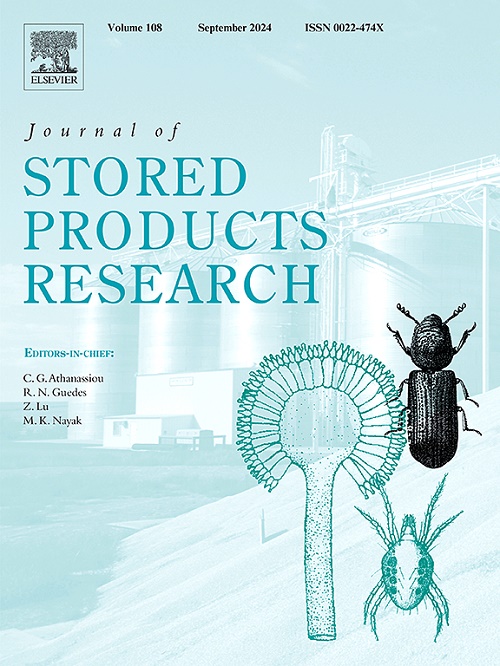Effects of complex cryoprotectant on the freeze-drying survival of Lactobacillus acidophilus FMNS-10 and its protective mechanisms
IF 2.7
2区 农林科学
Q1 ENTOMOLOGY
引用次数: 0
Abstract
Freeze-drying is a common method for preserving bacteria cells, but it can cause cell damage in the process of protection. Therefore, it is necessary to explore a cryoprotectant to improve cell survival during the process. This research aimed to explore the optimal cryoprotectant formulation of L. acidophilus FMNS-10 and its protection mechanism. The optimal cryoprotectant consisted of 10.7 % skim milk, 3 % sodium L-glutamate and 10 % D-trehalose, resulting in a survival rate of 91.69 % for L. acidophilus FMNS-10 after freeze-drying (p < 0.05). Under this condition, the integrity of cell wall and membrane of L. acidophilus FMNS-10 was close to that of the fresh strain, which could be attributed to preventing ice crystal formation. Cryoprotectants demonstrated a significant protective effect on enzymatic activities. In the cryoprotectant-free group, the activities of β-galactosidase, L-LDH, Na+/K+-ATPase and the concentration of Ca2+ decreased by 36.19 %, 51.82 %, 89.40 %, and 41.90 %, respectively. However, the cryoprotectant group were only 7.10 %, 1.66 %, 7.41 %, and 4.10 % reductions compared to the cryoprotectant-free group (p < 0.05). These results indicated that the optimal cryoprotectant improved the survival rate of L. acidophilus FMNS-10 by inhibiting the loss of enzyme activity. In addition, the optimal cryoprotectant significantly mitigated the DNA damage induced by freeze-drying. The reduction in enzyme and DNA damage may be attributed to complex cryoprotectants maintaining the stability of their three-dimensional structures and reducing structural disruption caused by freezing. Further analysis of storage stability revealed that the viable count of L. acidophilus FMNS-10 exceeded 107 CFU/mL when stored at −20 °C for 180 days. These findings provide a comprehensive theoretical foundation for how to freeze-dry Lactobacillus acidophilus.
复合冷冻保护剂对嗜酸乳杆菌FMNS-10冻干存活的影响及其保护机制
冷冻干燥是保存细菌细胞的常用方法,但在保护过程中会造成细胞损伤。因此,有必要探索一种低温保护剂来提高细胞在这一过程中的存活率。本研究旨在探讨嗜酸乳杆菌FMNS-10的最佳冷冻保护剂配方及其保护机制。最佳冷冻保护剂为10.7%脱脂乳、3% l -谷氨酸钠和10% d -海藻糖,冷冻干燥后嗜酸乳杆菌FMNS-10的存活率为91.69% (p <;0.05)。在此条件下,嗜酸乳杆菌FMNS-10细胞壁和细胞膜的完整性与新鲜菌株接近,这可能是由于防止了冰晶的形成。低温保护剂对酶活性有显著的保护作用。无冷冻保护剂组β-半乳糖苷酶活性、L-LDH活性、Na+/K+- atp酶活性和Ca2+浓度分别下降36.19%、51.82%、89.40%和41.90%。然而,与无冷冻保护剂组相比,冷冻保护剂组仅降低了7.10%,1.66%,7.41%和4.10% (p <;0.05)。这些结果表明,最佳冷冻保护剂通过抑制酶活性的丧失来提高嗜酸乳杆菌FMNS-10的存活率。此外,最佳冷冻保护剂显著减轻了冷冻干燥引起的DNA损伤。酶和DNA损伤的减少可能是由于复杂的冷冻保护剂保持了它们的三维结构的稳定性,减少了由冷冻引起的结构破坏。进一步的贮藏稳定性分析表明,在−20℃条件下保存180 d,嗜酸乳杆菌FMNS-10的活菌数超过107 CFU/mL。这些发现为如何冷冻干燥嗜酸乳杆菌提供了全面的理论基础。
本文章由计算机程序翻译,如有差异,请以英文原文为准。
求助全文
约1分钟内获得全文
求助全文
来源期刊
CiteScore
5.70
自引率
18.50%
发文量
112
审稿时长
45 days
期刊介绍:
The Journal of Stored Products Research provides an international medium for the publication of both reviews and original results from laboratory and field studies on the preservation and safety of stored products, notably food stocks, covering storage-related problems from the producer through the supply chain to the consumer. Stored products are characterised by having relatively low moisture content and include raw and semi-processed foods, animal feedstuffs, and a range of other durable items, including materials such as clothing or museum artefacts.

 求助内容:
求助内容: 应助结果提醒方式:
应助结果提醒方式:


